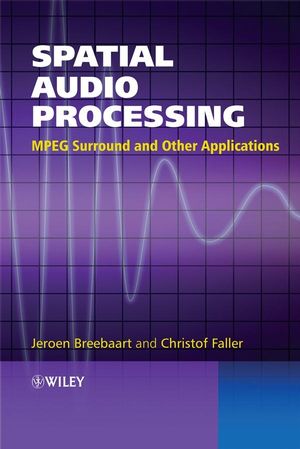Spatial Audio Processing: MPEG Surround and Other ApplicationsISBN: 978-0-470-03350-0
Hardcover
224 pages
December 2007
 This is a Print-on-Demand title. It will be printed specifically to fill your order. Please allow an additional 10-15 days delivery time. The book is not returnable.
|
||||||
Foreword.
Preface.
1 Introduction.
1.1 The human auditory system.
1.2 Spatial audio reproduction.
1.3 Spatial audio coding.
1.4 Book outline.
2 Background.
2.1 Introduction.
2.2 Spatial audio playback systems.
2.2.1 Stereo audio loudspeaker playback.
2.2.2 Headphone audio playback.
2.2.3 Multi-channel audio playback.
2.3 Audio coding.
2.3.1 Audio signal representation.
2.3.2 Lossless audio coding.
2.3.3 Perceptual audio coding.
2.3.4 Parametric audio coding.
2.3.5 Combining perceptual and parametric audio coding.
2.4 Matrix surround.
2.5 Conclusions.
3 Spatial Hearing.
3.1 Introduction.
3.2 Physiology of the human hearing system.
3.3 Spatial hearing basics.
3.3.1 Spatial hearing with one sound source.
3.3.2 Ear entrance signal properties and lateralization.
3.3.3 Sound source localization.
3.3.4 Two sound sources: summing localization.
3.3.5 Superposition of signals each evoking one auditory object.
3.4 Spatial hearing in rooms.
3.4.1 Source localization in the presence of reflections: the precedence effect.
3.4.2 Spatial impression.
3.5 Limitations of the human auditory system.
3.5.1 Just-noticeable differences in interaural cues.
3.5.2 Spectro-temporal decomposition.
3.5.3 Localization accuracy of single sources.
3.5.4 Localization accuracy of concurrent sources.
3.5.5 Localization accuracy when reflections are present.
3.6 Source localization in complex listening situations.
3.6.1 Cue selection model.
3.6.2 Simulation examples.
3.7 Conclusions.
4 Spatial Audio Coding.
4.1 Introduction.
4.2 Related techniques.
4.2.1 Pseudostereophonic processes.
4.2.2 Intensity stereo coding.
4.3 Binaural Cue Coding (BCC).
4.3.1 Time–frequency processing.
4.3.2 Down-mixing to one channel.
4.3.3 ‘Perceptually relevant differences’ between audio channels.
4.3.4 Estimation of spatial cues.
4.3.5 Synthesis of spatial cues.
4.4 Coding of low-frequency effects (LFE) audio channels.
4.5 Subjective performance.
4.6 Generalization to spatial audio coding.
5 Parametric Stereo.
5.1 Introduction.
5.1.1 Development and standardization.
5.1.2 AacPlus v2.
5.2 Interaction between core coder and spatial audio coding.
5.3 Relation to BCC.
5.4 Parametric stereo encoder.
5.4.1 Time/frequency decomposition.
5.4.2 Parameter extraction.
5.4.3 Down-mix.
5.4.4 Parameter quantization and coding.
5.5 Parametric stereo decoder.
5.5.1 Analysis filterbank.
5.5.2 Decorrelation.
5.5.3 Matrixing.
5.5.4 Interpolation.
5.5.5 Synthesis filterbanks.
5.5.6 Parametric stereo in enhanced aacPlus.
5.6 Conclusions.
6 MPEG Surround.
6.1 Introduction.
6.2 Spatial audio coding.
6.2.1 Concept.
6.2.2 Elementary building blocks.
6.3 MPEG Surround encoder.
6.3.1 Structure.
6.3.2 Pre- and post-gains.
6.3.3 Time–frequency decomposition.
6.3.4 Spatial encoder.
6.3.5 Parameter quantization and coding.
6.3.6 Coding of residual signals.
6.4 MPEG Surround decoder.
6.4.1 Structure.
6.4.2 Spatial decoder.
6.4.3 Enhanced matrix mode.
6.5 Subjective evaluation.
6.5.1 Test 1: operation using spatial parameters.
6.5.2 Test 2: operation using enhanced matrix mode.
6.6 Conclusions.
7 Binaural Cues for a Single Sound Source.
7.1 Introduction.
7.2 HRTF parameterization.
7.2.1 HRTF analysis.
7.2.2 HRTF synthesis.
7.3 Sound source position dependencies.
7.3.1 Experimental procedure.
7.3.2 Results and discussion.
7.4 HRTF set dependencies.
7.4.1 Experimental procedure.
7.4.2 Results and discussion.
7.5 Single ITD approximation.
7.5.1 Procedure.
7.5.2 Results and discussion.
7.6 Conclusions.
8 Binaural Cues for Multiple Sound Sources.
8.1 Introduction.
8.2 Binaural parameters.
8.3 Binaural parameter analysis.
8.3.1 Binaural parameters for a single sound source.
8.3.2 Binaural parameters for multiple independent sound sources.
8.3.3 Binaural parameters for multiple sound sources with varying degrees of mutual correlation.
8.4 Binaural parameter synthesis.
8.4.1 Mono down-mix.
8.4.2 Extension towards stereo down-mixes.
8.5 Application to MPEG Surround.
8.5.1 Binaural decoding mode.
8.5.2 Binaural parameter synthesis.
8.5.3 Binaural encoding mode.
8.5.4 Evaluation.
8.6 Conclusions.
9 Audio Coding with Mixing Flexibility at the Decoder Side.
9.1 Introduction.
9.2 Motivation and details.
9.2.1 ICTD, ICLD and ICC of the mixer output.
9.3 Side information.
9.3.1 Reconstructing the sources.
9.4 Using spatial audio decoders as mixers.
9.5 Transcoding to MPEG Surround.
9.6 Conclusions.
10 Multi-loudspeaker Playback of Stereo Signals.
10.1 Introduction.
10.2 Multi-channel stereo.
10.3 Spatial decomposition of stereo signals.
10.3.1 Estimating ps,b, Ab and pn,b.
10.3.2 Least-squares estimation of sm, n1,m and n2,m.
10.3.3 Post-scaling.
10.3.4 Numerical examples.
10.4 Reproduction using different rendering setups.
10.4.1 Multiple loudspeakers in front of the listener.
10.4.2 Multiple front loudspeakers plus side loudspeakers.
10.4.3 Conventional 5.1 surround loudspeaker setup.
10.4.4 Wavefield synthesis playback system.
10.4.5 Modifying the decomposed audio signals.
10.5 Subjective evaluation.
10.5.1 Subjects and playback setup.
10.5.2 Stimuli.
10.5.3 Test method.
10.5.4 Results.
10.6 Conclusions.
10.7 Acknowledgement.
Frequently Used Terms, Abbreviations and Notation.
Terms and abbreviations.
Notation and variables.
Bibliography.
Index.



